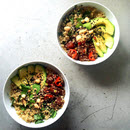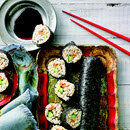
APEX Insights > Inspire > Foods that help you to prevent energy slumps

May 2020
Foods that help you to prevent energy slumps
Energy slumps affect all of us and don’t worry, it’s very normal to experience different energy levels throughout the day. It’s not just about the food that you eat, there are other factors involved. Hydration and sleep also play a big part when it comes to your energy levels. If you have a good diet and sleep well and stay hydrated then there may be another cause for lack of energy, which it’s best to see your healthcare professional about.
Get off the energy roller coaster with wholefoods
Increasing the amount of nutritious unrefined wholefoods can certainly help to boost your energy levels and get you off the energy rollercoaster. Wholefoods typically are nutrient dense and contain more nutrients than other foods which means you can maintain a healthy diet AND look after your energy levels. During the food processing treatment, some of the health-promoting nutrients such as fibre, micronutrients, vitamins and minerals can be pulled out leaving little or no nutrition behind.
When it comes to getting energy fast, carbohydrates can be a good quick fix, but the best thing to do is to opt for less refined carbs such as unprocessed or minimally processed whole grains and whole grain cereals like barley, bulgur, buckwheat, quinoa, and oats, dark sourdough or whole grainy bread, brown rice, lentils and beans. These will also enable you to focus more at work too!
Complex carbohydrates are the brain’s best energy source and are slower to digest and take longer for your body to breakdown. As they require more work to digest and assimilate, they deliver energy to your body more steadily and this will help stabilise blood sugar levels. However, some simple carbohydrates can be helpful such as fruit, due to the fibre content and dairy products. To avoid energy slumps it’s important to keep your blood sugar levels stable. If you have periods of low energy, moodiness or the jitters then it might be wise to eat a good breakfast and include protein with every meal. Good quality proteins such as fish, eggs, chicken, plant-based protein powders and dairy products can help to stabilize your blood sugar.
Supercharging your energy levels
Combining two or more food groups (macronutrients) such as carbohydrates and good fats can supercharge your energy levels. For example, if you’re eating an apple with nut butter, the apple provides quicker energy and the nut butter can help slow this down keeping you sustained longer. Carbs and protein when combined can also help you avoid blood sugar spikes and drops.
If you’re limiting your intake of food, its critical to ensure you’re eating enough to keep your body running efficiently.
Smart swaps
If the thought of low energy days are weighing you down, you can always try these smart swaps for healthier options which will provide you with more energy and keep you feeling full.
Help beat the slump with these delicious foods and recipes
There are also a number of delicious foods that help you to prevent energy slumps and keep your energy stabilised throughout the day.

Salmon
Salmon is high in omega 3 fatty acids, which have been shown to reduce inflammation in the body, which is a common cause of fatigue1. Omega 3 fatty acids also help to reduce levels of the protein hormone leptin. Leptin plays a critical role in controlling energy intake and energy expenditure. Lower leptin is linked to a faster metabolism.
Fatty fish also contains B12, which when combined with folic acid helps to produce red blood cells and assist iron delivery. Good levels of red blood cells and iron in the blood can help reduce fatigue and increase energy levels2.
Steam salmon or poach in a small amount of coconut water and use herbs, garlic, spices and lemon juice for flavour. Scatter smoked salmon into wraps or onto cauliflower pizza bases or roll it up in brown rice sushi rolls, or try this Supercharged Poke Bowl.

Leafy greens
Leafy greens will never weigh you down, and they'll flood your body with living micronutrients and chlorophyll that will pump oxygen into your blood and give you a hit of energy during a slump. Baby spinach, Swiss chard, kale, romaine, Cos and rocket are more nutrient dense than the standard iceberg and are still easy to eat raw in a salad. Chlorophyll can help oxygenate your blood and increase energy.
You might like this Gardeners Bounty Salad.

Brown Rice
Brown Rice is less processed and has more nutritional value than white. All rice, travels through several processes before it makes its way conveniently to your plastic package. Once picked, the seeds are milled to remove the outer husk. This results in simple, untarnished brown rice. Add a more few more steps and you’re immersed deep into the processing food chain and it’s fussed over, buffed up creation of white rice.
The inner bran and germ is removed and the rice is polished using something equally as tantalizing as glucose or talc. Yes, I am talking about that talc, the one that Granny Mabel likes to call her little specs of love dust and sprinkle lavishingly on important areas. The end result is a grain that has had most of its wonderful nutrients zilched. Plain white rice has less Vitamin E, thiamin, riboflavin, niacin, vitamin B6, folic acid, potassium, magnesium and iron and don’t forget to subtract three quarters of the fibre too. You can find a delicious Brown Rice Nori Roll recipe here - https://www.superchargedfood.com/blog/autumn/brown-rice-nori/

Bananas
Bananas are the ideal delight for restoring electrolytes. If you’re feeling a little sluggish, the natural sugars will restore your energy levels. They’re a great source of carbohydrates, potassium and vitamin B6, all of which can help boost energy levels in your body. Muscle cramps are a common sign of low potassium, electrolyte and hydration levels.
If your muscles are weak, tired or fatigued consider muscle nourishing foods that restore your electrolytes like banana. Muscles depend on electrolytes for contraction as well as relaxation. Electrolytes, especially sodium, potassium, calcium and magnesium, help your muscles function at optimal levels3.
What's better than eating a mango or banana? Drinking a mango AND banana! Switching up your berry smoothie with this healthy banana and mango smoothie is sure to put a smile on your face. You can watch a simple video about how to make it here.

Oats
Starting the day with a bowl of natural oatmeal will provide you with protein and energy. Oats are rich in beta glucan and soluble fibres that can also help with lowering cholesterol levels. Soluble fibres can assist in improving digestion, increasing the absorption of minerals and even assisting immune system function, increasing intestinal transit time and reducing glucose absorption.
As they’re high in fibre and complex carbohydrates this slows down the conversion to simple sugars, and the beta-glucan delays the fall before meals and slows the rise after meals4.
An even better way to enjoy oats is my delicious Gutmeal recipe.
If you have eaten a snack and feeling like your energy has crashed, the best thing to do is not to beat yourself up about it. Just ensure that you make your next snack or meal protein rich, or one with a good amount of fibre and try and eat regularly. Enjoy the recipes!
Gut health is important for your mental health and overall wellness, it’s one of the most important components of the body. We interact with it daily and it’s something intricately connected to many aspects of our everyday life.*
OnePath Life Limited (OnePath Life) is committed to deliver market leading mental health and wellness solutions with a focus on service, customer wellness and prevention. The focus on mental health and wellness is at the core to OnePath Life’s proposition. To deliver on our commitment, we have developed a suite of tools, education pieces, and collaborated with partners to provide our customers with the support they may need to facilitate a healthy life. OnePath Life has proudly partnered with Lee Holmes to provide education and nutritional inspiration for our customers to supercharge their health.
References
* Important note
The information related to your health is not intended to be a substitute for professional medical advice, diagnosis, or treatment. Always seek the advice of your physician or other qualified health provider with any questions you may have regarding a medical condition.
This material is intended for the use of financial advisers only and is distributed by OnePath Life Limited (OnePath Life) (ABN 33 009 657 176, AFSL 238341).
The information, opinions and conclusions in articles ("information") are current as at the date articles are written as specified within but are subject to change. The articles are provided and issued by OnePath Life unless another author is specified in the article, in which case it is provided and issued by that author. The views expressed are those of the authors only and do not necessarily reflect the opinions or views of OnePath Life, its employees or directors. Whilst care has been taken in preparing this material, OnePath Life and its related entities do not warrant or represent that the information is accurate or complete. To the extent permitted by law, OnePath Life and its related entities do not accept any responsibility or liability from the use of the information.
The information is of a general nature and has been prepared without taking into account a potential or existing investor’s objectives, financial situation or needs. Investors should consider whether the information is appropriate for them having regard to their objectives, financial situation or needs. For any product referred to above, OnePath Life recommends that investors read any relevant offer document or product disclosure statement and consider if the product is appropriate to them. For products issued by OnePath Life, these documents are available at access.onepathsuperinvest.com.au.
Past performance is not indicative of future performance and any case study shown is for illustrative purposes only. Neither are a prediction of the actual outcomes which will be achieved. Where tax or technical information is included, the information is our interpretation of the law and does not represent tax advice. An investor is advised to obtain professional advice relevant to their individual circumstances.